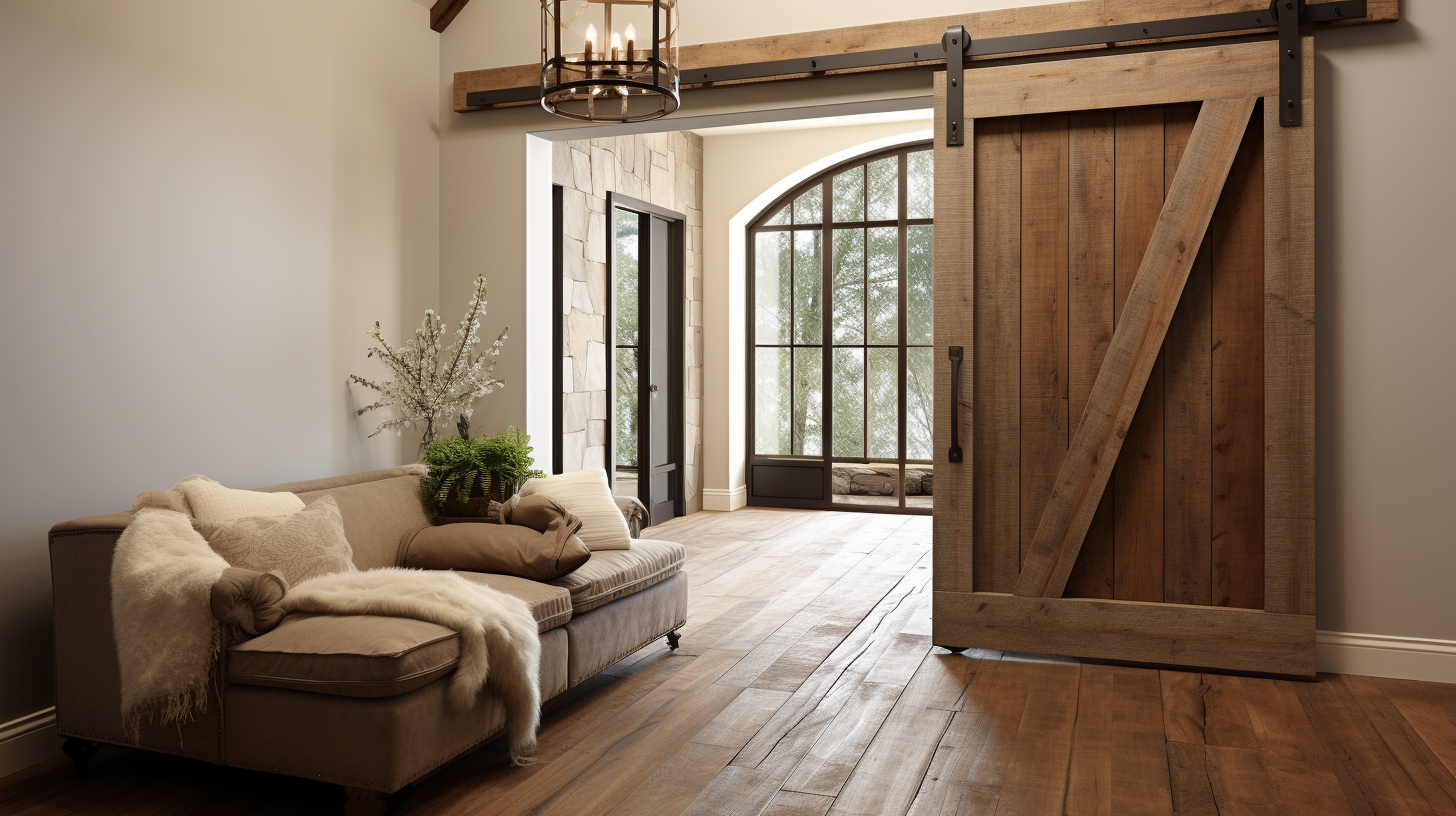Have you ever paused to admire the rustic elegance of a barn door and found yourself wondering, “Are barn doors soundproof?“
It’s a question that might seem odd at first, given the barn door’s agricultural origins, but it’s one that’s increasingly relevant in our modern, noise-filled environments.
Barn doors, with their blend of old-world charm and modern design, have transitioned from farmhouses to urban dwellings.
But as they make this transition, understanding their soundproofing capabilities becomes crucial for homeowners and designers alike.
Whether you’re contemplating installing a barn door in your home or are simply curious about their acoustic properties, you’re in the right place.
Let’s dive into the world of barn doors and unravel the mysteries of their soundproofing capabilities.
What Is A Barn Door?
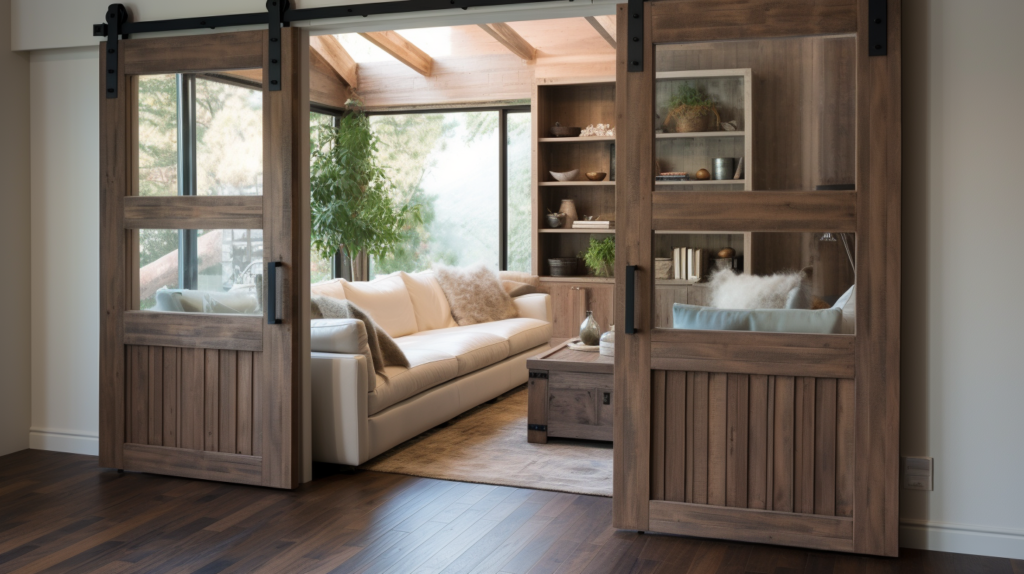
Barn doors, as the name suggests, trace their origins to agricultural settings.
Their primary function was to provide easy access to barns, allowing for the movement of large machinery and animals.
Structurally, these doors needed to be durable to endure the changing seasons and rigorous farm activities. This durability was often achieved using sturdy woods and reinforced fittings.
However, as architectural and interior design trends evolved, the barn door transformed from a purely functional entity to a decorative piece.
Urban and suburban homes began to adopt these doors not for their original purpose but for their aesthetic appeal.
The ruggedness of the barn door, combined with its unique sliding mechanism, offers a blend of rustic charm and modern functionality.
The fusion of old-world charm with contemporary design elements has catapulted the barn door from the farm to modern living spaces.
Today, you’ll find barn doors in upscale lofts, cozy apartments, corporate offices, and boutique hotels.
Are Barn Doors Soundproof?
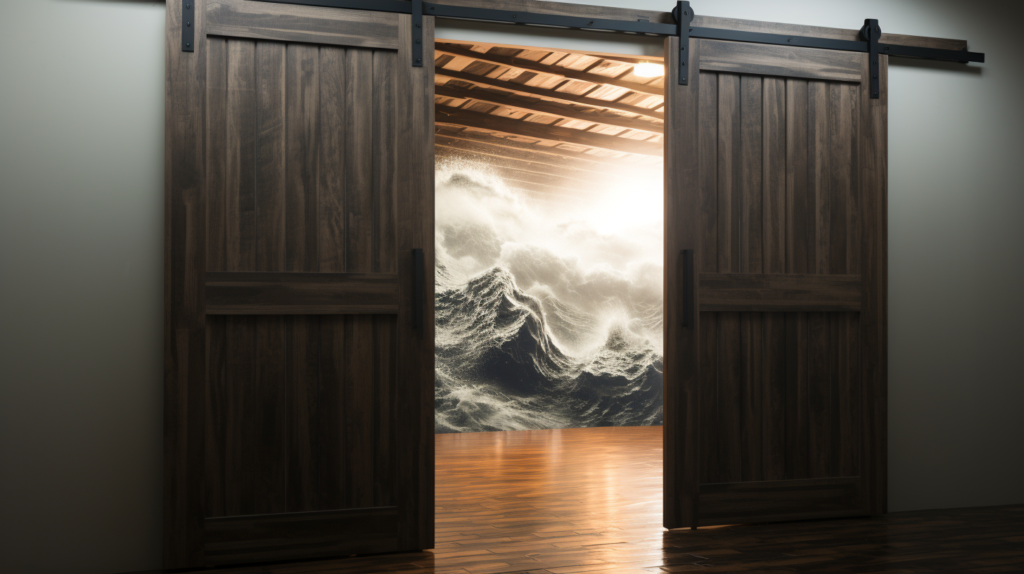
Barn doors, despite their aesthetic appeal, come with unique challenges in the realm of soundproofing.
Their sliding mechanism inherently results in a less-than-perfect seal.
This means that there are often gaps at the sides, top, or bottom, which can become channels for sound transmission.
This is in stark contrast to traditional hinged doors that can shut tight, sealing off most gaps.
Moreover, barn doors come in a plethora of designs and materials.
While a solid wood barn door might offer decent sound insulation, a door with large glass panels or decorative cutouts will naturally be less effective.
The door’s hardware, often celebrated for adding to the barn door’s charm, can also be a weak link in soundproofing.
Rollers, tracks, handles, and other fittings, if not chosen or installed with care, can compromise the door’s overall soundproofing capabilities.
Basics Of Soundproofing

At its core, soundproofing revolves around controlling sound waves. To understand this, one must delve into the behavior of sound.
Sound waves spread like ripples in water, emanating from the source.
When these waves encounter barriers, such as walls or doors, a portion of the sound gets reflected, some gets absorbed, and the rest is transmitted through the barrier.
For effective soundproofing, the goal is to minimize the transmitted sound while maximizing reflection and absorption.
Soundproofing is often confused with sound absorption, but there’s a clear distinction.
While soundproofing is about preventing sound from entering or leaving a space, sound absorption aims to enhance the acoustic quality within a space.
Sound absorption materials soak up the sound, reducing reverberations and echoes, thereby making sounds clearer and less distorted.
Factors Affecting The Soundproofing Capabilities Of Doors

Doors play a pivotal role in a room’s soundproofing. Their efficacy as sound barriers depends on several factors.
The primary determinant is the door’s material.
Solid materials, such as thick woods or metals, naturally impede sound waves more effectively than lightweight or porous materials like glass or thin plywood.
The reason is simple physics: denser materials provide more resistance to the vibrating air molecules that carry sound.
However, the material is just one piece of the puzzle. The door’s thickness plays a crucial role too.
Thicker barriers are generally more challenging for sound waves to penetrate, offering superior sound insulation.
But even the thickest door can falter in its soundproofing duties if it has gaps or if it’s not sealed properly.
Tiny gaps or cracks around a door can act as conduits for sound, rendering the door’s other soundproofing properties moot.
Hence, the installation, sealing, and maintenance of the door are as vital as the door’s inherent properties.
Limitations Of Barn Doors In Soundproofing
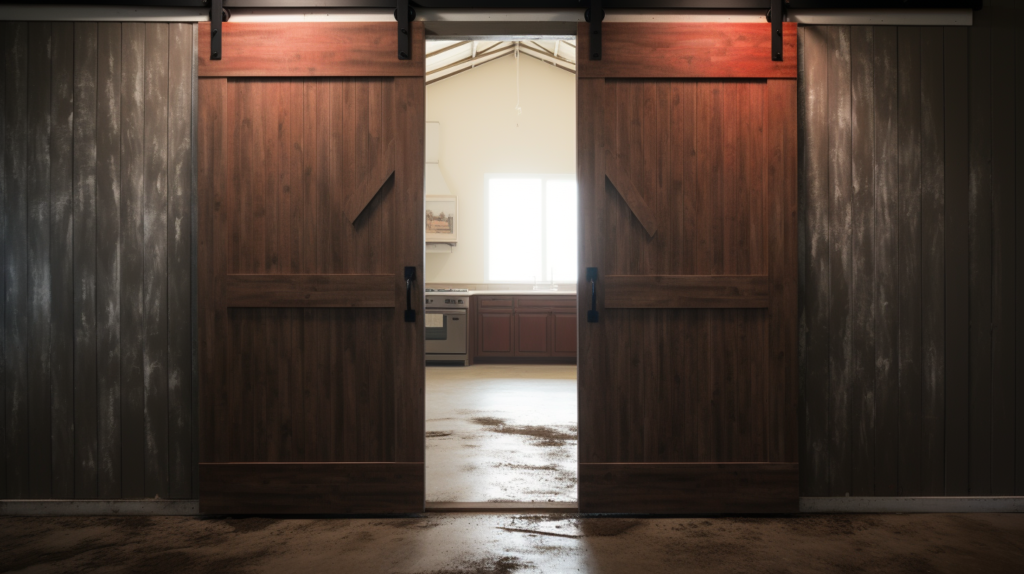
Every design choice comes with its set of advantages and limitations. With barn doors, while the design and aesthetic flexibility are clear advantages, they do have inherent soundproofing limitations.
The sliding mechanism of barn doors, although space-saving and stylish, doesn’t allow for the kind of airtight seal you can achieve with traditional swing doors.
Even the minutest misalignment during installation can create gaps, leading to significant sound leakage.
Another often overlooked aspect is resonance. Large barn doors, especially if not properly supported or anchored, can act as resonating bodies.
This means that they can amplify certain frequencies, leading to increased noise levels.
Furthermore, while gaps at the sides or top of the door are often considered, the bottom of the door can also be a significant point of sound leakage, especially if not equipped with proper seals or sweeps.
Ways To Enhance The Soundproofing Of Barn Doors
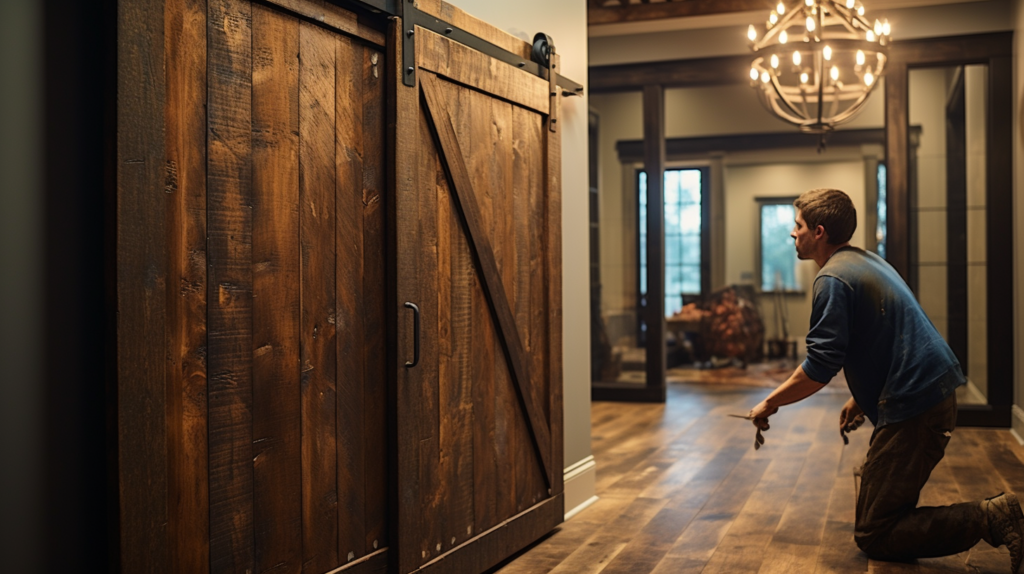
For those smitten by the charm of barn doors but concerned about soundproofing, there’s good news.
Various modifications can enhance the soundproofing capabilities of barn doors. One of the most common solutions is weatherstripping.
By adding weatherstripping around the door, you can seal off many of the gaps that allow sound to pass. This not only aids in soundproofing but can also help in thermal insulation.
Another approach is to add mass to the door. This can be achieved by hanging soundproofing curtains or dense blankets.
These add-ons provide an additional layer of material that sound waves need to penetrate, thereby reducing sound transmission.
If aesthetics is not a concern, acoustic panels or tiles can be affixed directly to the door. These are designed to trap and diffuse sound, further enhancing the door’s soundproofing.
A more advanced solution might involve installing a secondary door or barrier, creating an air gap and providing an additional sound barrier.
Comparing Barn Doors To Other Door Types For Soundproofing
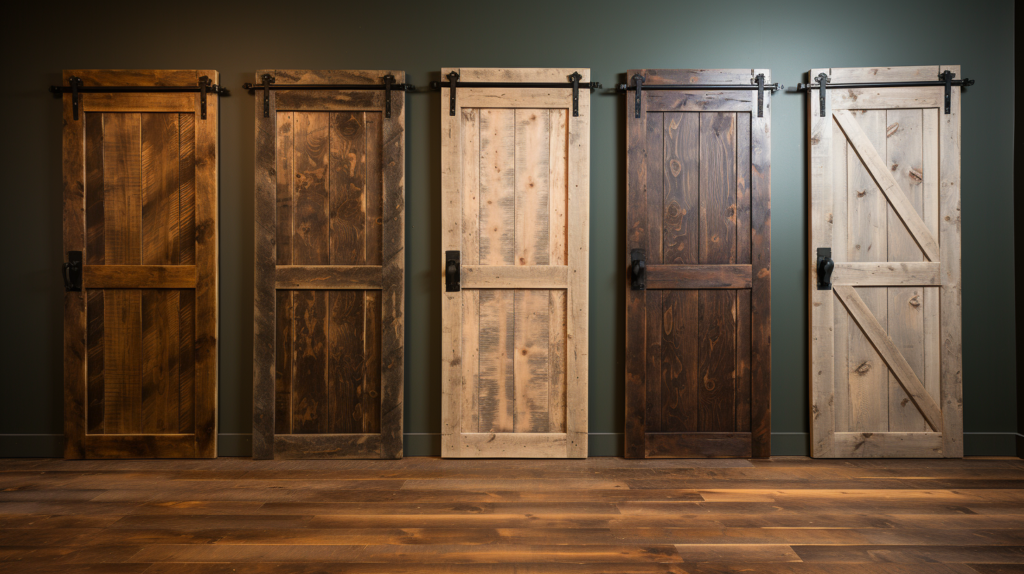
When evaluating soundproofing options, it’s beneficial to compare barn doors with other types of doors.
Traditional swing doors, especially those that are solid and well-sealed, often come out on top in soundproofing comparisons.
Their design allows for a tight seal, and the absence of sliding mechanisms means fewer gaps. Pocket doors, another sliding door variant, have many of the same soundproofing challenges as barn doors.
In the vast spectrum of doors, the distinction between solid core and hollow core doors is also significant.
As the names suggest, solid core doors are filled with a solid material, making them denser and more effective at soundproofing.
Hollow core doors, being lighter and less dense, might not offer the same level of sound insulation.
For spaces where soundproofing is paramount, like recording studios or theaters, specialized acoustic doors are the go-to choice. Engineered for maximum sound insulation, these doors often incorporate multiple layers of dense materials, specialized seals, and advanced design principles to keep sound at bay.
Practical Scenarios: When Are Barn Doors Suitable?
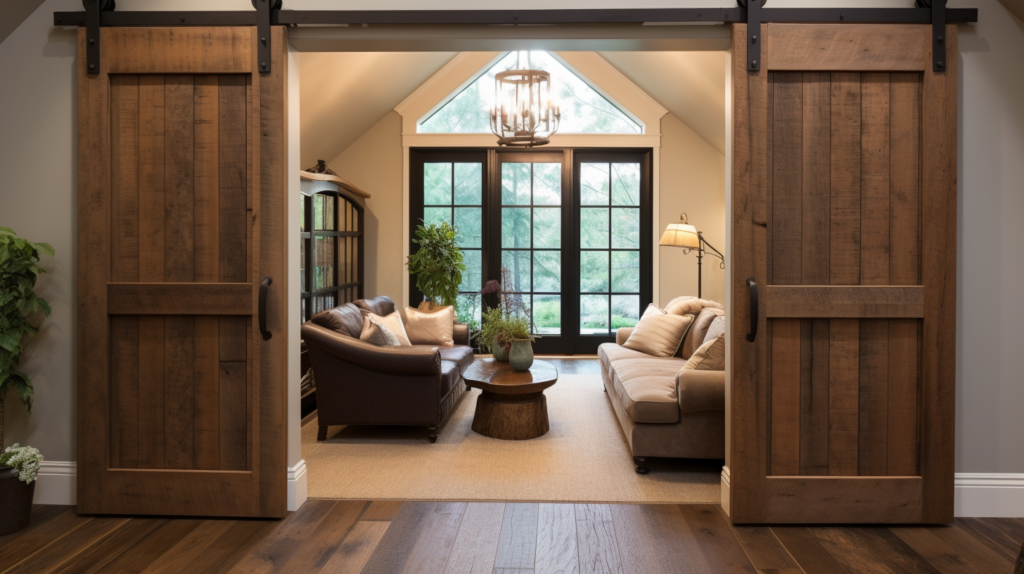
The decision to install a barn door should be influenced by both aesthetic preferences and practical considerations.
In residential settings, such as a bedroom or study, where the emphasis might be more on aesthetics and space-saving than on absolute soundproofing, barn doors can be a fantastic choice.
However, in environments like boardrooms, where confidential discussions take place, or in home theaters, where sound clarity is paramount, one might need to think twice.
In commercial settings, the use of barn doors can be a design statement, reflecting a company’s modern and unconventional ethos.
However, from a practical standpoint, soundproofing considerations might dictate their placement and use.
It’s always a balance between form and function. In some scenarios, the aesthetic appeal of a barn door might outweigh its functional limitations, making it the preferred choice.
Conclusion
Barn doors, with their rich historical roots and undeniable aesthetic charm, have carved a niche in contemporary design.
While they offer a unique blend of rustic allure and modern functionality, it’s essential to understand their soundproofing capabilities and limitations.
Like any design choice, they come with trade-offs. While they might not be the first choice for soundproofing purists, with the right modifications, they can certainly hold their own.
It’s all about knowing what you need and being willing to make the necessary adjustments.
Whether it’s in a chic urban loft, a cozy suburban home, or a sleek corporate office, barn doors have the potential to be both a design statement and a functional asset.
The key lies in making informed decisions, striking the right balance between style, functionality, and practicality.
